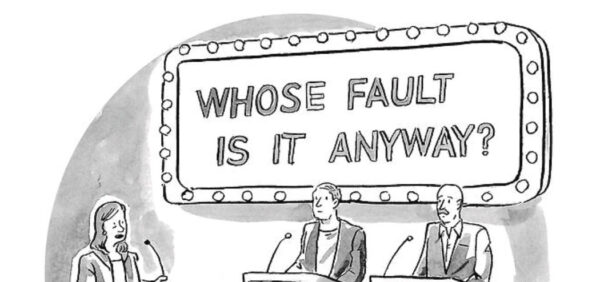In workplaces and beyond, mistakes are inevitable. The way we handle them, however, makes all the difference. A New Yorker cartoon I recently came across captures this perfectly… here's part of it:

A frustrated host standing on a stage under a banner that reads “Whose Fault Is It Anyway?”
Instead of seeking answers, the host pleads,
“For the love of God, it doesn't really matter–I just want to move on to Round Two, where we address the problem and try to stop it from happening again.”
This humorous image reflects a critical reality in organizational life. Too often, we waste time pointing fingers or assigning blame instead of focusing on what really matters: solving the problem and learning from it to prevent recurrence. In my book, The Mistakes That Make Us, I emphasize this shift as foundational for cultivating a culture of learning and continuous improvement.
When blame becomes the norm, people naturally hide mistakes to protect themselves. This stifles innovation, impedes problem-solving, and ultimately undermines success. On the other hand, when we replace blame with curiosity and constructive reflection, we create an environment where individuals and teams feel psychologically safe to admit mistakes, analyze them, and work toward improvement.
This mindset is what distinguishes high-performing organizations like Toyota, where mistakes and problems are seen as opportunities for growth rather than reasons for punishment.
The question, then, is not “Whose fault is it?” but rather “What can we learn?”
Mistakes should lead us to reflection and positive change. In a culture that prioritizes learning, mistakes become stepping stones for growth. They are not signs of failure but signals that our systems, processes, or assumptions may need adjusting. This perspective encourages action and drives progress.
Here's a challenge: take a moment to reflect on your organization's approach to mistakes. Are you stuck in “Round One,” focusing on blame and accountability? Or have you moved on to “Round Two,” where you analyze, learn, and prevent issues from recurring?
The shift is not just about better results–it's about building trust, fostering innovation, and creating a workplace where people feel empowered to learn and grow. As I argue in my book, mistakes can make us, if we respond to them constructively.
Let's move on from Round One. Progress starts when blame stops.
What are your thoughts on handling mistakes in your organization? How do you ensure that learning takes priority over blaming? Share your experiences in the comments.
What do you think? Please scroll down (or click) to post a comment. Or please share the post with your thoughts on LinkedIn – and follow me or connect with me there.
Did you like this post? Make sure you don't miss a post or podcast — Subscribe to get notified about posts via email daily or weekly.
Check out my latest book, The Mistakes That Make Us: Cultivating a Culture of Learning and Innovation:










In my opinion, I think this is a great post! I thought it really captured the overall idea of moving away from blaming someone for a mistake within an organization to that person instead learning from that mistake and being able to confide to someone of what happened.
I completely agree with Mark that time is wasted when people within an organization spend more time pointing fingers at people when a problem arises rather than solving that problem and coming up with improvement ideas for it to not happen again. This article correlates back to Lean Six Sigma through the message of continuous improvement and the process of doing a root cause analysis for when a mistake/problem occurs.
In fact, I am currently in the process of getting my green belt and we just discussed in class helpful tools such as the 5 Whys and the fishbone diagram.
A question that came to mind when reading this blog post was how would you suggest a leader/boss to reinforce that if someone does make a mistake that they are in an environment where mistakes are a learning opportunity and not something that results in a punishment?
Overall, I thought this post was an excellent read!
Great post! I think in today’s work culture people are accustomed to finding someone to blame for a mistake, although in most scenarios no one is at fault. You make some great points about the impact that blame culture has on trust and change with-in a company.
[…] Whose Fault Is It Anyway? The Case for Studying Over Blaming – Mark Graban explains errors ought to lead us to reflection and constructive change–it is about constructing belief, fostering innovation, and making a office the place individuals really feel empowered to study and develop. […]